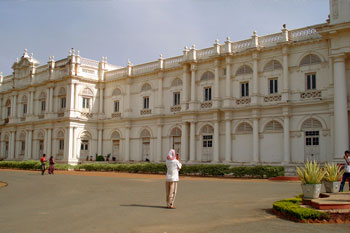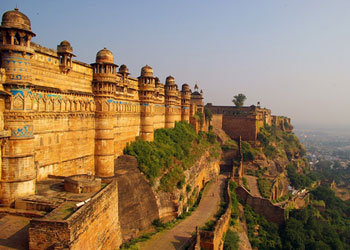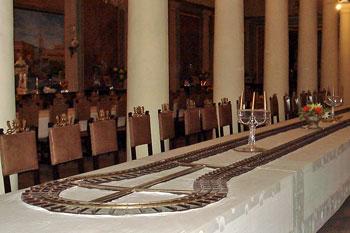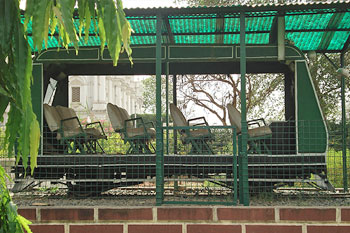Photographs: Rediff Archives Archana Masih
The 'uncle' who led the way on his scooter -- that will be the most endearing memory of Gwalior.
It was our first day in Gwalior, it was 4 in the evening and we were famished. All we had eaten was one triangle of a cucumber sandwich shared by Yashodhara Raje, the BJP MP, from her tiffin while campaigning in a rocky-barren stretch of a harsh landscape.
Hungry for a good Indian meal we were reminded of what her son Akshay Bhansali had told us while remembering his good old school days at the Scindia School. "Ah, the chicken at Kwality was great. I make it a point to go there each time I visit Gwalior."
And that's where the kind uncle on the scooter led us. We stopped to ask him the way as he sat on his scooter talking to someone under a shady tree. With a heave, he propped the scooter on the stand and politely walked to the driver's window to give the direction.A taste of small town India
Image: A taste of small town IndiaDarshan Singh, our driver, was from Bhopal. Unfamiliar with the streets of Gwalior, he was utterly confused. Seeing that he wasn't getting through, uncle turned around and said, "Just follow me," and vroomed ahead.
The restaurant had moved to a new location, uncle pointed towards it, smiled and drove away. His sweet gesture, a warm reminder of those little niceties small town India still retains.
The food at Kwality was exceptionally good. Good, sumptuous north Indian fare served by friendly waiters. It was tea time, but at the surrounding tables there was quite a lot of butter chicken -- the waiter told us that was their speciality.
Just by the proprietor's desk was a table with a group of regulars, reading newspapers over cups of tea, discussing what else -- but politics.
Of the three days we were to spend in the city, we had three meals and one take away from the restaurant.
Gwalior has its Cafe Coffee Day, McDonalds and Big Bazaar, thronged by youngsters. It has its chaat, kachodi and mithai -- good enough eating options for quick bites on the go.
The pearl amongst fortresses
Image: The majestic Gwalior Fort built by Raja Man Singh TomarThe city of Gwalior lay below the hill as the fort shone brilliantly under the lights of the son-et-lumiere. It was a story magically told, of a collage of legends, vigniettes and epistles of history, some of which ring out with a familiarity common to all school children in India.
The siege by Mahmud Ghazni; the jauhar by proud Rajput queens; an enthralled Babar calling it 'the pearl among the fortresses of Hind'; the city's musical genius Tansen; the courage of Rani Laxmibai, who died defending its walls.
Bundele Harbolon ke mooh hamne suni kahani thi
Khoob ladi mardani woh toh Jhansi wali Rani thi
One of the most moving poems written about the Indian freedom struggle, these powerful lines by Subhadra Kumari Chauhan moved my colleague from Tamil Nadu to tears.
After an engaging 45-minute show, we wound our way down past the Scindia school, the 9th century 100 feet high Teli ka Mandir, the gurdwara built in memory of the sixth Sikh Guru Hargobind Singh who was imprisoned by Jehangir in the Gwalior Fort.
A wine train on the dinner table
Image: Miniature tracks on the long banquet table for the wine trainA part of the palace has been converted into a museum with interesting displays on the second floor. The grand Darbar Hall is the main focus of interest where a security guard informs that the last function to be held was a Presidential banquet hosted for President Pratibha Patil.
"All the lights of the chandeliers were lit then," he informs us, going on to explain how ten elephants first tested the roof before the chandeliers were first hung. The other much sought after artifact is the silver train with cut glass wagons carrying wine decanters. The train used to chug on miniature tracks on the long banquet table, as guests poured themselves a drink as it passed each individual seated for dinner.
Of palanquins and bagghis
Image: The palace museum houses some real beautiesWe tried picking some picture post cards but the disinterested attendant at the ticket counter told us they did not have any. So many of India's best sites have no memorabilia to carry back with you which is such a disappointment.
Gwalior though stays on in the archives of the mind.






Comment
article